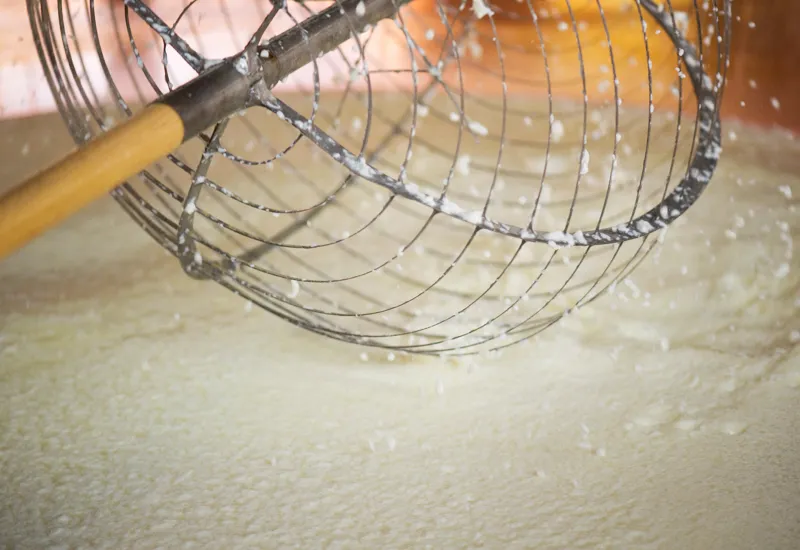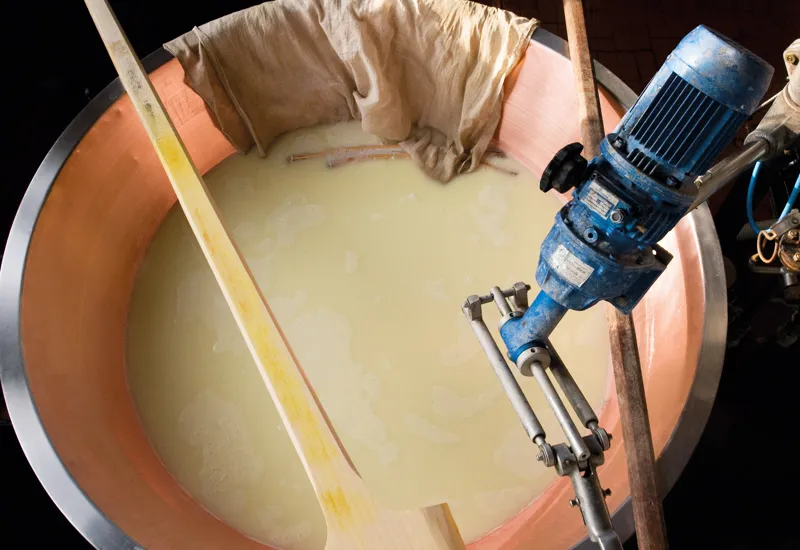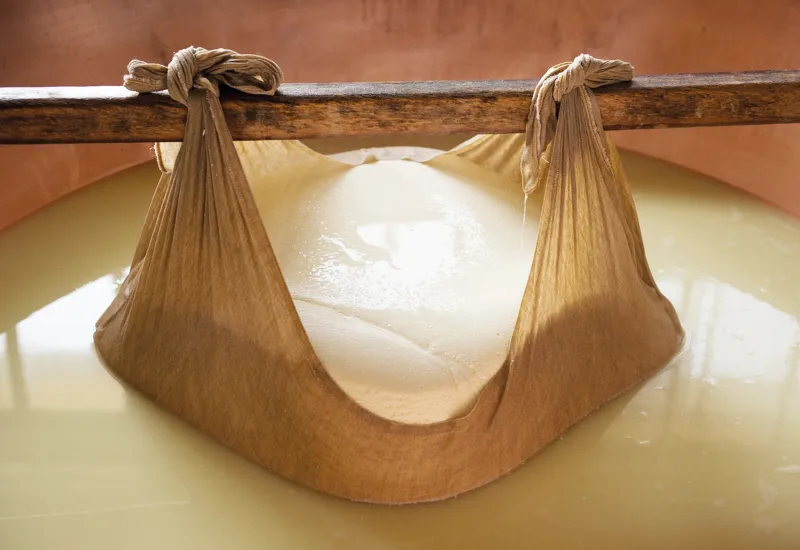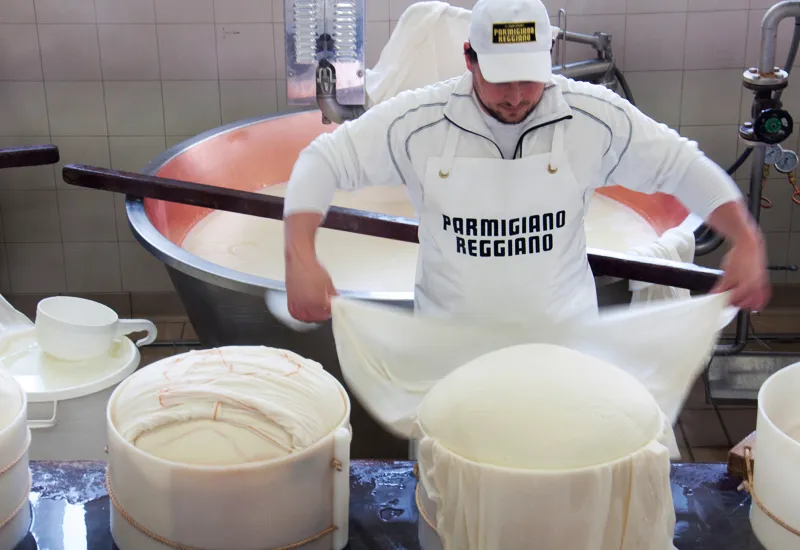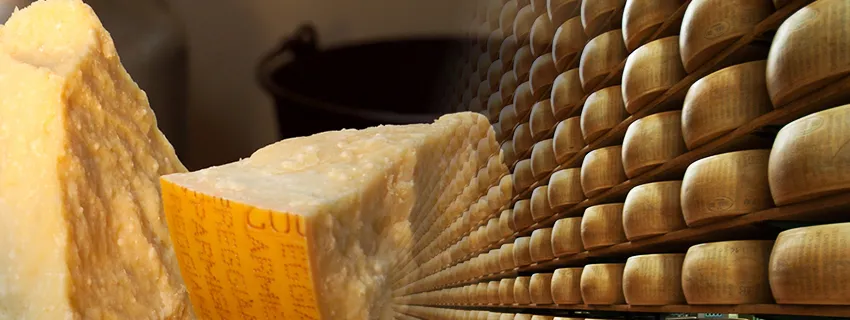Published:
Author: Antonio Maria Guerra
How Is Parmesan Made?

In this article we will find out how Parmigiano Reggiano, the original Parmesan cheese, is made: from the milk to the maturation. An artisanal process, handed down from generation to generation by the most traditional producers, gathered in the Consorzio del Formaggio Parmigiano Reggiano. Enjoy the reading!

How is Parmesan made?
Parmigiano Reggiano, the original Parmesan, belongs to the category of ‘hard cheeses’: these are characterized by a low water content (less than 35% / 40%) and a seasoning that, sometimes, can be very long. Here follows the steps to produce this dairy specialty (click here for the printable version):

01. The skimmed milk from the milking of the previous evening, together with that of the morning milking is poured in large copper boilers. Veal rennet and whey are added;

02. In about ten minutes the milk condenses forming the ‘curd’. Skillful cheese artisans, using an instrument known as ‘spino’, fragment the curd into small grains;

03. A slow cooking phase begins, using a temperature that can reach 55 degrees. The curd condenses into a fairly compact mass that slowly reaches the bottom of the cauldron;

04. The cheesemakers extract this mass and cut it in two. These portions are wrapped in a cloth to drain them and then placed in a mold that gives them the typical cylindrical shape;

05. A casein plate is inserted: this shows a progressive number identifying the wheel. Additional identifiers are engraved on the edge of the wheel using a special marking band;

06. The wheels are immersed in brine, a solution of water and salt. The salt slowly penetrates the cheese. The maturation begins: it will last at least 12 months;
Let’s find out the fascinating origins of Parmigiano Reggiano, the original Parmesan cheese, as well as a great number of information and interesting facts. To read the article, please click on this LINK.
How is Parmesan made? Infographic.
Click HERE to view (and, eventually, download) a printable document showing the steps necessary to produce Parmigiano Reggiano, the original Parmesan cheese.
The cows for Parmigiano Reggiano cheese.
One of the main characteristics of Parmigiano Reggiano is the great quality of the milk used to make it.
Read more
This milk is produced by two different types of cow: the ‘Frisona’, more productive, and the traditional ‘Regiana Rossa’, that gives life to a very tasty cheese.
Parmesan: the seasoning.
Parmigiano Reggiano, the original Parmesan, acquires much of its personality during its seasoning, this takes place in silent places, where hundreds of wheels quietly rest, neatly arranged on long wooden shelves.
This seasoning, according to the product specification document, must last at least 12 months: in this regard, it’s important to note that this particular cheese starts to give its best after two years.

Testing Parmesan cheese.
Before being commercialized, the wheels of Parmigiano Reggiano undergo a long and careful selection to guarantee the highest quality level.
This selection is conducted by the ‘battitore’ (‘beater’), an expert not very different from the sommelier, who performs a series of tests on each wheel using particular tools.
For example, the ‘battitura’ (‘beating’), is performed with a small ‘percussion hammer’ and is useful to evaluate the internal structure of the wheel.
Read more
According to the results of these tests, Parmigiano Reggiano is classified as follows:
- Prima categoria (First category): This cheese has no defects. Consumers can easily distinguish it because the wheel appears intact, including the marks on its surface;
- ‘Mezzano’: This cheese has minor or medium imperfections. In this case, the side of the wheel is marked with horizontal fissures. This cheese is not suitable for seasoning but is perfect when ‘fresh’;
- ‘Scarto’ (‘Scrap’): This cheese has too many defects to be sold. The side of the wheel is scraped to erase any sign.

The brand of Parmigiano Reggiano cheese.
Many signs make it possible to easily distinguish an original wheel of Parmigiano Reggiano cheese. Among the most evident, the brand impressed along its entire side (*1) using the ‘marking brand’ (*2). Here follows some of them:
- The name PARMIGIANO-REGGIANO marked in dots;
- The words ‘DOP’ and ‘Consorzio Tutela’;
- The serial number;
- The production date.
Read more
There is also a casein plate on the surface, this shows: an alphanumeric identification code, a special label for optical readers and the initials CFPR (Consorzio Formaggio Parmigiano Reggiano).
The wheels of Parmigiano Reggiano that, after extensive tests, prove to be of particular value, can boast of the brands PREMIUM or EXPORT (*3).
Note:
*1: The ‘scanso’.
*2: The ‘marking band’ (‘fascera marchiante’) is a band with raised characters: these are imprinted on the cheese when it’s still soft.
*3: Those that have minor or medium imperfections can be distinguished thanks to horizontal fissures engraved on the side of the wheel.
The wheel of Parmigiano Reggiano.
Parmigiano Reggiano is produced in cylindrical blocks (‘wheels’) with a slightly rounded side known as ‘scanso’. Here follow some numbers to give an idea about the dimensions of these blocks:
- Face diameter: from 35cm to 45cm (about 13.5 to 17.5 inches);
- Height: from 20cm to 26cm;
- Crust thickness: 6mm (about 0.2 inches);
Read more
According to the product specification document, each wheel must weigh at least 30 kilos: a remarkable value considering that to produce each kilo, 13.5 liters of milk are needed.

Parmigiano Reggiano cheese PDO.
In 1996 Europe assigned the Protected Designation of Origin (PDO) to Parmigiano Reggiano: with this legal act, the Community not only has certified the unique characteristics of this cheese but has also pledged to protect them from any imitation attempt.
Read more
The Denomination establishes in fact that Parmigiano Reggiano, to be defined as such, must respect the rules contained in a specific ‘product specification document’. These rules include, for example, precise indications on the ingredients, the production area and the appearance of the cheese.

The product specification document.
The ‘product specification document’ of Parmigiano Reggiano is the document containing the rules to be followed by cheese producers to make the original ‘Parmigiano Reggiano DOP’.
Read more
These rules concern, for example, the place of origin of the milk, the production area, the preparation technique, the appearance and so on.
It’s possible to download this document directly from the official website, please click HERE (Courtesy of Consorzio del Parmigiano Reggiano).

Consorzio del Parmigiano Reggiano: contacts.
Address: Via John Fitzgerald Kennedy, 18
42124 Reggio Emilia (RE)
Website: www.parmigianoreggiano.it
Mail: staff@parmigianoreggiano.it
Tel.: +39 0522 307741
Copyright information.
The images displayed on this page belong to WebFoodCulture and to the Consorzio del Parmigiano Reggiano, with the only exception of the following:
Public domain images:
- PDO Logo (Wikipedia Link);

